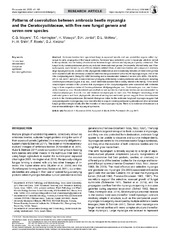| dc.contributor.author | Mayers, CG | |
| dc.contributor.author | Harrington, TC | |
| dc.contributor.author | Masuya, H | |
| dc.contributor.author | Mcnew, DL | |
| dc.contributor.author | Jordal, Bjarte Henry | |
| dc.contributor.author | Shih, H-H | |
| dc.contributor.author | Roets, F | |
| dc.contributor.author | Kietzka, GJ | |
| dc.date.accessioned | 2020-07-03T10:59:19Z | |
| dc.date.available | 2020-07-03T10:59:19Z | |
| dc.date.issued | 2020 | |
| dc.Published | Mayers, Harrington, Masuya H, Jordal BH, Mcnew, Shih, Roets, Kietzka. Patterns of coevolution of ambrosia beetle mycangia and the Ceratocystidaceae, with five new fungal genera and seven new species. Persoonia. 2020;44:41-66 | eng |
| dc.identifier.issn | 1878-9080 | |
| dc.identifier.issn | 0031-5850 | |
| dc.identifier.uri | https://hdl.handle.net/1956/23315 | |
| dc.description.abstract | Ambrosia beetles farm specialised fungi in sapwood tunnels and use pocket-like organs called mycangia to carry propagules of the fungal cultivars. Ambrosia fungi selectively grow in mycangia, which is central to the symbiosis, but the history of coevolution between fungal cultivars and mycangia is poorly understood. The fungal family Ceratocystidaceae previously included three ambrosial genera (Ambrosiella, Meredithiella, and Phialophoropsis), each farmed by one of three distantly related tribes of ambrosia beetles with unique and relatively large mycangium types. Studies on the phylogenetic relationships and evolutionary histories of these three genera were expanded with the previously unstudied ambrosia fungi associated with a fourth mycangium type, that of the tribe Scolytoplatypodini. Using ITS rDNA barcoding and a concatenated dataset of six loci (28S rDNA, 18S rDNA, tef1-α, tub, mcm7, and rpl1), a comprehensive phylogeny of the family Ceratocystidaceae was developed, including Inodoromyces interjectus gen. & sp. nov., a non-ambrosial species that is closely related to the family. Three minor morphological variants of the pronotal disk mycangium of the Scolytoplatypodini were associated with ambrosia fungi in three respective clades of Ceratocystidaceae: Wolfgangiella gen. nov., Toshionella gen. nov., and Ambrosiella remansi sp. nov. Closely-related species that are not symbionts of ambrosia beetles are accommodated by Catunica adiposa gen. & comb. nov. and Solaloca norvegica gen. & comb. nov. The divergent morphology of the ambrosial genera and their phylogenetic placement among non-ambrosial genera suggest three domestication events in the Ceratocystidaceae. Estimated divergence dates for the ambrosia fungi and mycangia suggest that Scolytoplatypodini mycangia may have been the first to acquire Ceratocystidaceae symbionts and other ambrosial fungal genera emerged shortly after the evolution of new mycangium types. There is no evidence of reversion to a non-ambrosial lifestyle in the mycangial symbionts. | en_US |
| dc.language.iso | eng | eng |
| dc.publisher | Naturalis Biodiversity Center | eng |
| dc.rights | Attribution-Non Commercial-No Derivatives CC BY-NC-ND | eng |
| dc.rights.uri | http://creativecommons.org/licenses/by-nc-nd/4.0/ | eng |
| dc.title | Patterns of coevolution of ambrosia beetle mycangia and the Ceratocystidaceae, with five new fungal genera and seven new species | eng |
| dc.type | Peer reviewed | en_US |
| dc.type | Journal article | en_US |
| dc.date.updated | 2020-01-17T11:56:55Z | |
| dc.description.version | publishedVersion | |
| dc.rights.holder | Copyright 2019-2020 Naturalis Biodiversity Center & Westerdijk Fungal Biodiversity Institute | eng |
| dc.identifier.doi | https://doi.org/10.3767/persoonia.2020.44.02 | |
| dc.identifier.cristin | 1731012 | |
| dc.source.journal | Persoonia | |

